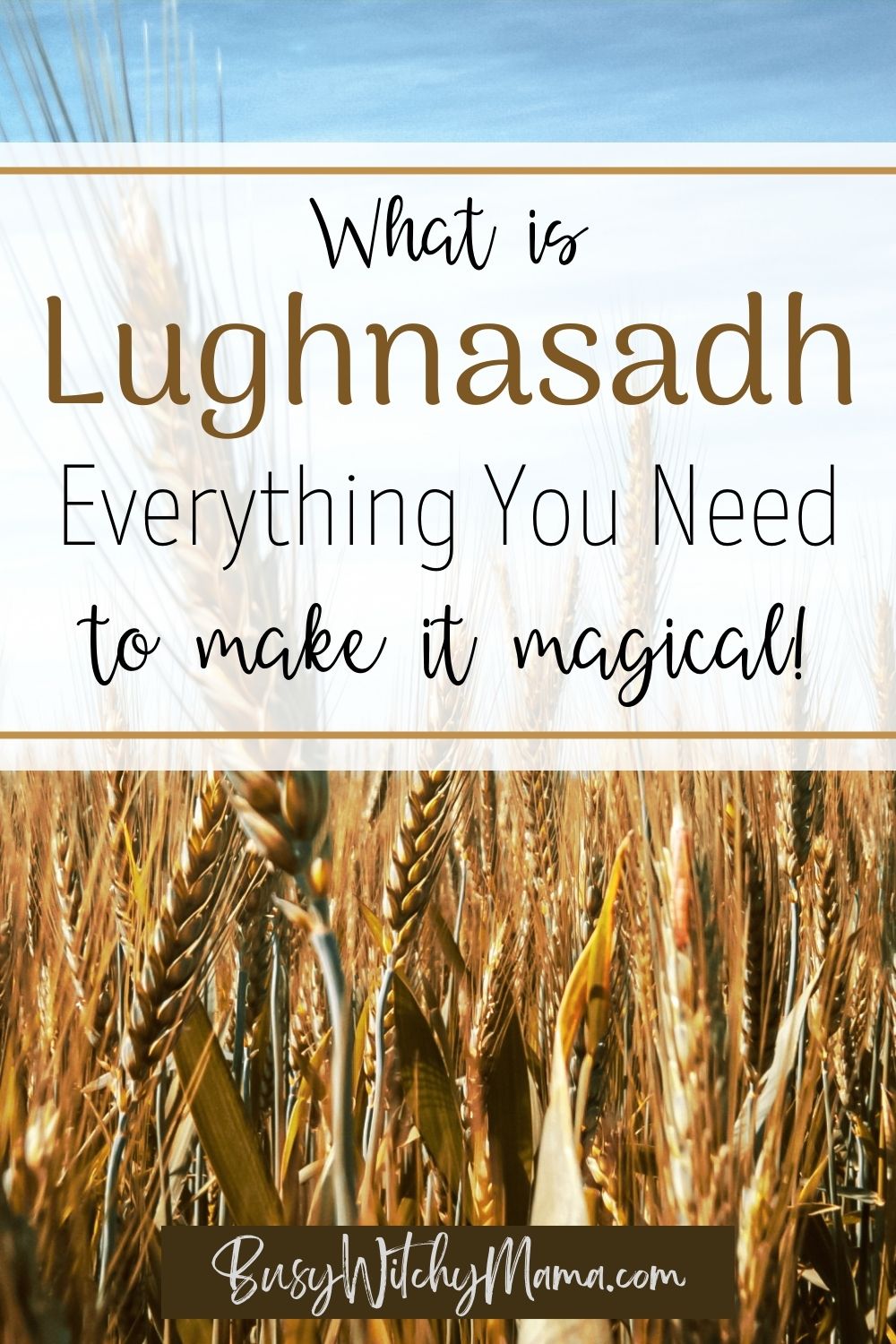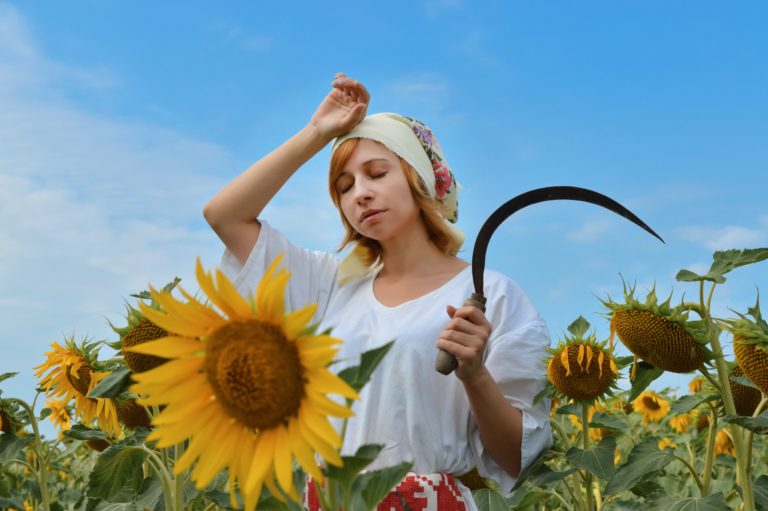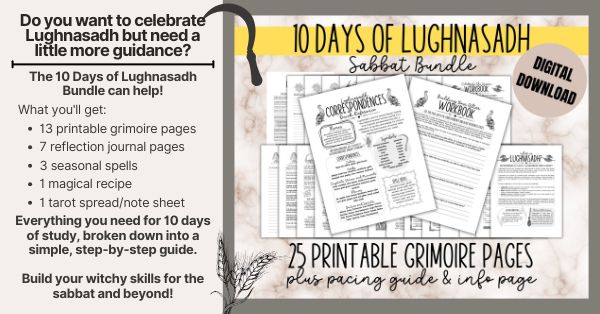
Can you believe we’re already almost half way through summer? You know what that means! It’s Lughnasadh time. Maybe you’re wondering, what is Lughnasadh? Fortunately, you’ve come to the right place.
In today’s post, we’ll look at all the basics and correspondences of Lughnasadh. When you’re done reading, you’ll be able to build your own magical Lughnasadh celebration based on the themes that most strongly speak to you.
Busy Witchy Mama is a participant in the Amazon Services LLC Associates Program, an affiliate advertising program designed to provide a means for sites to earn advertising fees by advertising and linking to Amazon.com. This post may contain affiliate links through Amazon or other affiliate programs. If you choose to make a purchase through an affiliate link, I make a small commission at no additional cost to you. All opinions are my own and I only recommend products that I believe in. Read my full disclosure here. Thank you for your support!
Grab printable grimoire pages of your favorite Lughnasadh posts, and take your learning to the next level with a ten day step-by-step study guide based on my very own grimoire! Grab your copy now.
Table of Contents
ToggleWheel of the Year - What are the Sabbats?
Early pagans (and also just early humans, really) relied completely on the cycles of the seasons for survival. They had to know when the growing seasons started, peaked, and finished in order to grow enough food to make it through winter. Different cultures observed these cyclical changes in varying ways, but most ancient cultures did observe them in some form.
In modern times, most of us don’t worry about growing food for survival anymore, so we’ve become detached from the cycles of nature. Luckily, all us modern witches and pagans can still tap into these cycles by observing the Wheel of the Year – the eight Sabbats.

What are the origins of the Wheel of the Year?
The Wheel of the Year is Wicca’s answer to modern witches seeking communion with the cycles of nature. These festivals were created by Gerald Gardner, regarded as the founder of modern Wicca. I believe these are modern festivals, but he’ll tell you they’re rooted in ancient tradition. Far be it from me to argue with Gardner. I don’t personally think it matters whether they are ancient or modern.
What does matter to me, though, is knowing the origins of these celebrations. The 4 greater Sabbats (Imbolc, Beltane, Lammas/Lughnasadh, Samhain) are based in Celtic and western European origins, while the other 4 lesser Sabbats (Yule, Ostara, Litha, Mabon) mark the transitional times between the greater Sabbats.
Why is this important? Well, Britain and western Europe have a very specific annual cycle based on their climate. Spring often starts to peek its head out in February, and the growing season is done by the first of November. Winter is cold and snowy, and summer is one big, long growing season.
What If I Don't Live in Europe?
If you live in Texas, Northern Canada, Mexico, the entire Southern Hemisphere, or any number of other places in the world, your annual cycles look different. Your winter might start late like mine. You might not have a winter at all. Maybe you have growing dead zones in December and July. You might even need to observe those changes in the opposite order!
While the Wheel of the Year is well established as a tradition, your input as a witch matters. The best way to celebrate the Sabbats is to learn about them and modify them to be specific to your area. Trust your intuition, and trust your environment when determining what traditions are important to you and which ones you will leave behind. The Wheel of the Year, after all, is meant to help you connect to the cycles of nature.
But I'm Not Wiccan. Can I Still Celebrate?
I’ve never met a Wiccan who will tell you no, though I’m sure they exist. Pretty much everyone I’ve ever spoken to or read information from agrees that the Wheel of the Year is accessible to all of us. Even those of us who are not Wiccan. Modern witchcraft is so variable. There’s no rule book, and you get to make it your own. These celebrations bring us all together even when we are so different. What is witchcraft? Learn more here.
The Wheel of the Year includes associated deity, and the history centers on stories about the god and goddess. However, it’s up to you to decide if that speaks to you.
For many of us, myself included, The Wheel of the Year is simply a great way to reconnect with our environment and the natural cycles of all living things. For others, each Sabbat is a piece of the story that tells their faith.
I feel that as long as we all respect each other, the 8 Sabbats can totally serve both purposes!
The Wheel of the Year begins on November first and ends on October 31. The festivals alternate between solar observances and earth centered observances. Each Sabbat comes with its own themes, correspondences, and traditions that infuse your whole year with magic rooted in the shifts of your climate and seasonal patterns.

What is Lughnasadh? The History
Lughnasadh (loo-nah-sah) is the first of three Celtic harvest festivals that will occur between August and October. It marks the time that falls directly between the summer solstice (Litha) and the fall equinox (Mabon).
Sometimes also called Lammas, meaning loaf mass, Lughnasadh is celebrated from July 31st to August 1st in the northern hemisphere and from January 31st to February 1st in the southern hemisphere.. However, the date of celebration can vary between groups and cultures.
Lughnasadh is tricky because it exists in this weird in-between space. In-between summer and fall, life and death, abundance and sacrifice, culmination and destruction. It’s not quite either thing, and yet it’s both. Then, of course, there are so many different climates to consider. It’s hard to celebrate first harvest if that’s not your situation.
Where I live, this isn’t first harvest season at all! It’s second growing season. Nearly everything in my garden has been dead or ravaged by bugs for weeks. In my zone, we’re all getting ready to start our fall seeds indoors, anxiously awaiting the day when the temperature falls below 100° F (like 37° C) again. Our wheat harvest is done, and our corn harvest hasn’t even started yet.
That doesn’t mean we can’t celebrate Lughnasadh, though. We just have to apply what we learn to our own circumstances! That’s why I like to think about the next 3 sabbats as parts of the same big celebration.
- Lughnasadh represents potential; what could be. There’s still plenty of time to set things right if your plans and goals aren’t working out.
- Mabon represents realization; your current circumstances for better or worse and your last chance to make a change.
- Samhain represents completion; the cycle is complete, and now you must prepare to rest and survive with what you have harvested.
Believe it or not, Lughnasadh is also a great time for spirit work. You know that membrane-like veil that separates the world of the living from the world of the dead? And how it’s super thin at Samhain? Well, all of that transitional energy also makes the veil super thin at Lughnasadh, Beltane, and Imbolc – all sabbats that fall directly between solstices and equinoxes.
Spiritually, this is considered the time when the god will be sacrificed, and the goddess is once again pregnant with the god, who will be reborn at Yule. This is very much a time of transition in every sense of the word.
Lughnasadh is a time for harvesting and celebrating, but also for planning and preparation. If there’s anything you wish to set in motion for the remainder of the year, now is the time to act on it!
Lughnasadh Themes and Symbols
When I ask myself, “What is Lughnasadh?”, the first place I go for inspiration is the themes of the season. This determines all my altar decor and many of my favorite celebrations. Consider what is going on in nature where you live. Then use these themes to figure out what kind of Samhain celebrations you want to have.
For example, where I live, it’s basically still the dead of summer and the hottest time of the year. The garden has been dust for several weeks, and it’s time to start planning the fall garden. North Texans are anxiously awaiting the return of stormy weather, which we simulteniously pray for and fear. We’re not harvesting around here. We’re in survival mode and planning out our next cycle of growth.
Themes of Lughnasadh
These are some of the common themes of Lughnasadh, but don’t feel confined by this list. First and foremost, you should always listen to your intuition and defer to the cycle of the seasons in your area to honor these changes. August in England is very different from August in North Texas where I live. For this reason, I pay careful attention to seasonal cycles relevant to North Texas when trying to determine, just what is Lughnasadh?
- abundance – whether it’s your first harvest or second growing season, our gardens in the month of August are either teeming with life, or they’re about to be.
- creativity – we’re still in that fiery, sacral, creative life force time of year, so use this month to really dig into creative projects you want to finish and new skills you hope to learn.
- family and ancestral ties – harvest season is a wonderful time to connect with your ancestors because the harvest was such a difficult season. Life and death literally hung in the balance from August to October.
- first harvest – the time when grains are typically harvested.
- gratitude – practice gratitude for the things you are able to harvest at this time.
- growth – there’s still plenty of growing season left to achieve your goals and reap the rewards.
- home and hearth – with the heat of summer in full swing, the school year kicking back up, and fall right around the corner, we can spend this time preparing our homes and spending time with loved ones.
- potential – This is our first harvest festival and the first opportunity to begin reaping what we have sown this year.
- prosperity – this is a great time to be grateful for what we have and start planning for how we will harvest what we still need.
- protection – with the colder, darker months of autumn looming, take time now to protect the abundance present in your life.
- reflection – since there’s lots of growing season left, you still have plenty of time to reflect and adapt if things haven’t gone the way you hoped.
- sacrifice – as a harvest festival, the theme of sacrifice runs deep.
- transformation and transition – Did you know that all the major sabbats occur in transitional times between the solstices and equinoxes? We are in between seasons as well as being in between the living and spirit worlds. We’re also moving into autumn. Consider how you will change and move forward.et

Symbols of the Season
In the US, we don’t have any major holidays or celebrations that coincide with Lughnasadh, so I think about what’s happening in nature and the kinds of life shifts, like county fairs, craft fairs, and back to school season, that are occurring when looking for inspiration.
- brooms and besoms – cleansing.
- butterflies – transformation, ancestral ties, and in my area, the butterfly migration begins in mid August.
- cauldrons – feminine energy and transformation.
- coins – abundance, wealth, harvesting blessings.
- corn husk dolls – represent harvest and sacrifice.
- dragons – it’s still insanely hot and sunny out, so dragons can represent fire, heat, and solar energy.
- hearth and hearth fire – representation of family, ancestral ties, and spending more time indoors.
- mortar and pestle – transformation, herbal and kitchen magic.
- old keys – open doors and pathways to new opportunities.
- pentacles – represents money and wealth.
- seeds – potential.
- scythes and sickles – harvest and sacrifice.
- shells – represent the ocean and water, the cradle of life on Earth, feminine energy, and ancient wisdom.
- stag – solar energy, fertility, abundance, strength.
- the Sun – we’re still deep in the throes of summer, after all.
- water – beach season (not to mention storm season!) hasn’t quite ended yet, and the final weeks of summer are still a great time for cleansing with natural waters.
- wheat stalks/corn husks – sacrifice and harvest.
- wheat pennies – abundance, and a great way to include grain in your altar if you have a grain allergy.
Lughnasadh Colors, Herbs, and Crystals
You can use these correspondences to bring Lughnasadh flair to your decorations, foods, altar, and spell work.
Lughnasadh Colors
When choosing Lughnasadh colors, look to nature for inspiration. Consider which plants and flowers are in bloom and the color scheme of the world outside your door. Build your color palette to fall somewhere between summer and fall; not quite the bright and vibrant shades of summer, but not quite rich jewel tones of fall either! Here are some of the most common colors of the season.
- deep red – blood, ancestral ties .
- yellow – solar energy, happiness, and transformation.
- green – abundance, growth, prosperity, fertility, and wealth.
- gold – gifts for ancestors, the guarantee of comfort in colder months, success, and harvest.
- brown – nature, the Earth, soil, roots, harvest, sacrifice.

Herbs, Plants, and Oils of Lughnasadh
These seasonal herbs, plants, and oils can be infused into your spells, meals, and even decor to add some herbal inspiration to your Lughnasadh season. I am not a master herbalist or doctor. As with all medicines, treat carefully, and do your research. Don’t take unnecessary risks.
- allspice – supports immune health, good luck, money, wealth, strength.
- basil – protection, abundance, money, wealth, love, psychic visions.
- bay – manifesting wishes, prosperity, spirit communication, dream work.
- cinnamon – brings abundance and prosperity, promotes fertility and good health, shielding.
- cornflower – fertility, abundance, luck, psychic energy.
- garlic – protection, defense, purificaiton.
- marigold – communication with ancestors, solar energy, protection, vitality, abundance, protection.
- mint – abundance, growth, tenacity, money.
- poppy – psychic visions, protection, dream work, spirit communication.
- rose – passion, defense, protection, binding.
- rosemary – healing, protection, supports mental and psychic power, solar energy, protection, tenacity, abundance.
- sunflower – solar energy, happiness, joy, abundance.
Lughnasadh Crystals and Stones
These crystals and stones are perfect for home and altar decor. They’re also great for infusing your spell work and your day with the energy of Lughnasadh. I don’t recommend putting any crystals directly in water. If you choose to use crystals in baths or elixers, I suggest using an indirect infusion method. Please do your research.
- brass – solar energy, prosperity, protection.
- carnelian – healing, protection, creative potential, strength, courage.
- citrine – success, luck, solar energy.
- clear quartz – a great energy amplifier during a time that’s all about abundance and growth.
- fossilized crystals and stones – help you connect to your ancestors and ancient wisdom.
- gold – wealth, abundance, prosperity, strength, courage.
- green aventurine – abundance, luck, prosperity, success.
- lodestone – attracts desires to you, grounding, balancing.
- moss agate – growth, abundance, prosperity.
- pyrite – abundance, clarity, protection.
- sunstone – solar energy, cleanses negativity, removes blocks, joy, communal energy.

Flavors of Lughnasadh
Any seasonal foods and drinks this time of year make the perfect addition to your Lughnasadh celebration. These are some of the most common suggestions as well as a few of my favorites.
- apples – while apples are a big symbol of Mabon, apple harvesting season begins in Autust, magical energy, spirit communication, abundance!
- beer, ale, mead, mulled cider, and wine – great for the preservation of grains and fruits, but also a popular offering to spirits and ancestors.
- blackberry – protection, bindings, abundance, strength, defense.
- bread – represents sacrifice and abundance.
- cider – a delicious way to utilize freshly harvested apples.
- corn and grain – represents sacrifice and harvest, death and rebirth.
- berries – we’re coming up to the end of berry season, so enjoy those final harvests.
- grapes – abundance, fertility, money, romance, stress relief.
- jams and jellies – great for preserving harvests of berries, grapes, and other seasonal fruits
- seeds of all types – , help connect us to the past, represent growth, abundance, and potential blessings
What is Lughnasadh? Activities to Bring Magic to Your Lughnasadh Season
Mundane Ways to Celebrate Lughnasadh
Maybe you’re short of time or looking to get skeptical family members involved in Lughnasadh. Perhaps you’re just not super into the witchy aesthetic, or spiritual stuff makes you uncomfortable. These fun activities are just the ticket for helping you reconnect with the cycles of the season without the pressure to include actual spell work.
- Go on a nature walk. If you’ve got kids, let them pick up sticks, leaves, flowers, and acorns. You can bring them home and set up a simple science investigation to help your little witchlings learn about the changing season. My oldest loves looking at everything under a magnifying glass, while the baby loves crunching and squishing whatever she can get her hands on!
- Research your ancestry or buy an ancestry kit to learn about who and where you come from. If you’re adopted and don’t have ties to your bio-family, I believe that your adoptive ancestors will still connect with you! They’re totally your family. Want to know if your ancestors were accused of witchcraft? Ancestry.com has a database for that now!
- Wear the colors of the season. Go simple with painted nails or a tie. Alternately, go full out with a head to toe Lughnasadh inspired outfit.
- Bake some bread. Nothing says Lughnasadh like fresh baked bread enjoyed with friends and family.
- Go berry picking. Or apple picking, or whatever kind of picking is available at farms in your area.
- Reflect on the goals you set for the year. Assess what worked, and consider what you still want to change.
- Learn to preserve food, and get into the spirit of the harvest season
- Connect with your community by visiting a county or craft fair.
- Visit the Farmer’s Market, and grab some fresh, seasonal produce to honor the harvest season.
- Enjoy the final days of summer with beach trips, lake visits, pool parties, and family picnics.
- Physically clean your home in preparation for spending more time indoors.
- Adopt a local, unkempt grave site. Connect to the spirit realm during this transitional time by caring for the resting place of someone who has passed.
- Give back to your community. Honor the energy of sacrifice by giving time or donations to your local shelter or food pantry. Sacrifice your literal life force energy by donating blood to your local blood bank.
- Gather the family together and share stories about passed relatives.
- Start brewing up your herbal remedies and medicinal infusions. Back to school season is coming, which means flu season will be close behind.
- Practice gratitude by spending time each day contemplating what you are thankful for.

Witchy Ways to Celebrate Lughnasadh
If you want to infuse some magic into your season, these activities are perfect for all you witches at heart.
- Set up your Lughnasadh altar. Include the colors, foods and symbols you have learned about here!
- Set up an ancestral altar to honor your dead (pets included). Fill it with photos, family heirlooms, and favorite foods/drinks of your passed loved ones. Work with it often, and by Samhain, you’ll be super connected to your spirits.
- Harvest magical herbs. If you didn’t get the chance to do so at Litha, Lughnasadh is another potent time for harvesting herbs.
- Make a corn dolly to use in your decor and ritual. On Lughnasadh day, you can burn it and spread the ashes in your garden, or bury it to usher in abundance.
- Refresh your home wards and protections. Make sure you hold on to all those blessings from the year.
- Set up your kitchen altar. With harvest season comes the perfect time to work some kitchen witchery, hearth magic, and green witchcraft into your practice.
- Carry the crystals of the season with you. Choose one stone per week over the 6 or so weeks of the Lughnasadh season. Then, make sure to pay attention to what you notice, and journal about your experience. Perhaps you’ll find a new favorite.
- Perform home blessings and abundance magic. This is the perfect time of year for bringing that last burst of sunshiney energy and prosperity into your home.
- Collect grave dirt for spells. Proceed with caution! Never take soil from an actual grave. Instead, collect from near the entrance of the cemetery. Leave an offering for the gift of the dirt, and listen to your intuition. If your gut says no, it’s best to leave the soil untouched.
- Leave offerings to your ancestors, deities, and guides, or to nature or local spirits.
Divination for the Lughnasadh
You can always rely on your favorite forms of divination any time of year. However, these are some of my favorites that I feel truly embrace the themes of the season.
- Pull out your favorite tarot or oracle deck.
- Learn about weather divination.
- Cast corn kernels in place of runes, bones, or stones.
- Try your hand at scrying. Scrying with water or fire lends itself well to this time of year.
Lughnasadh Spell Ideas for Seasonal Magic
Whether you have loads of time for an elaborate ritual, or you’re a busy witch with no spare time, you’ll find spell ideas here to perfectly suit your needs and bring in the themes of Lughnasadh.
- Gratitude Magic
- Garden and Seed Blessings
- Abundance Magic
- Growth Spells
- Kitchen Magic
- Self Care Rituals
- Cleansing Magic
- Protection Magic
- Protection Charms
- Home Protection Spells
- Success Spells
- Spirit Work
- Connect with Your Ancestors

Spirits and Deities of Lughnasadh
Lughnasadh is the time of year for deities of harvest and sacrifice. Solar gods and mother goddesses are also commonly honored. Here are a few examples to guide your research if deity work interests you. This list is NOT exhaustive and really only scratches the surface.
Goddesses of Harvest and Sacrifice
- Ceres – Roman harvest goddess.
- Corn Mother – Native American corn goddess.
- Demeter – Greek goddess of grain, the fields, and harvest. Mother of Persephone. Her grief at losing her daughter was said to explain the cycles of dormancy that occur each year.
- Hestia – Green hearth goddess.
- Inanna – ancient Mesopotamian goddess of love, fertility, and war.
- Parvati – Hindu harvest goddess.
- Persephone – Greek goddess of the Underworld, an example of sacrifice, and the reason for changing seasons in Greek mythology.
- Sedna – Inuit goddes of life and death.
- Selu -Cherokee corn goddess.
- Tailtiu -Foster mother of the god Lugh, who died from exhaustion after working to clear the forests of Ireland, and make room for crops to grow.
- Vesta – Roman hearth goddess.
- XochiQuetzal – Mexican goddess of the cycles of life.
Gods of Harvest and Sacrifice
- Adonis -Assyrian god of Dying Summer Vegetation
- Cernunnos – ancient Celtic god of nature, flora, fauna, and fertility, often represented with antlers or horns similar to the Horned God.
- Cronus – Green primordial harvest god.
- Lugh – Celtic god of the sun and harvest
- Mercury – Greek messenger god, associated with grain and commerce.
- Odin – Norse father god whose mythology includes many acts of self sacrifice.
- Saturn – Roman god of harvest, agriculture, strength, and justice.
- Sobek – Egyptian god of the Nile, whose flooding brings fertile soil.
- Tammuz – Sumerian God of Crops
Spirits
- John Barleycorn – the spirit of the harvest who is said to die with the grain harvest.
- The Grain Mother – a seasonal reference to the goddess
How Do You Celebrate Lughnasadh?
As you can see, Lughnasadh can mean so many different things to each of us. You have a lot of options to make your Lughnasadh magical! It all just depends on what rings true and what lines up with our surroundings.
What is your favorite way to celebrate Lughnasadh? Do you have any traditions I didn’t mention here? I’d love to hear about them!
So, what is Lughnasadh to you?


